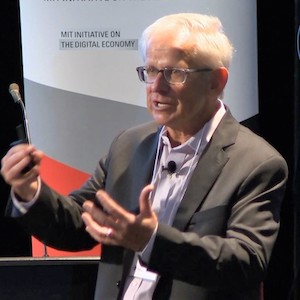 Fast Company ran an interesting article The Most Important Design Jobs of the Future, predicting 18 of the most important design jobs of the future (at least 3 to 5 years out). A couple of them were in health care, and arguably all of them would have some impact on health care, but I thought it might be fun to do a similar list specific to health care, and not limited to design. Let's hope no one comes back in a few years to show how wrong I was. I'll skip the usual suspects -- e.g., doctors, nurses, pharmacists. Yes, those jobs will (almost) certainly still be around, but they may not be central as they are today. And those jobs will evolve in ways that reflect the trends illustrated by the jobs I list...
Fast Company ran an interesting article The Most Important Design Jobs of the Future, predicting 18 of the most important design jobs of the future (at least 3 to 5 years out). A couple of them were in health care, and arguably all of them would have some impact on health care, but I thought it might be fun to do a similar list specific to health care, and not limited to design. Let's hope no one comes back in a few years to show how wrong I was. I'll skip the usual suspects -- e.g., doctors, nurses, pharmacists. Yes, those jobs will (almost) certainly still be around, but they may not be central as they are today. And those jobs will evolve in ways that reflect the trends illustrated by the jobs I list...
 Platform businesses scale differently than traditional businesses. Platforms scale through network effects. In the previous post, we introduced and described a widely used metaphor: pipes vs. platforms. Traditional businesses are pipes. Their value chains are linear. Value is added at sequential stages before a final product or service is delivered to consumers at the end of the pipeline. Platforms do not produce goods or services themselves—they make connections among stakeholders and facilitate value exchange among those stakeholders. Value is created outside the platform. Both pipeline businesses and platform businesses strive to achieve scale—but the type of scale they strive for is vastly different. In this post, we’ll explain how pipeline businesses strive for economies of scale (on the supply side) and how platform businesses scale through network effects (on the demand side).
Platform businesses scale differently than traditional businesses. Platforms scale through network effects. In the previous post, we introduced and described a widely used metaphor: pipes vs. platforms. Traditional businesses are pipes. Their value chains are linear. Value is added at sequential stages before a final product or service is delivered to consumers at the end of the pipeline. Platforms do not produce goods or services themselves—they make connections among stakeholders and facilitate value exchange among those stakeholders. Value is created outside the platform. Both pipeline businesses and platform businesses strive to achieve scale—but the type of scale they strive for is vastly different. In this post, we’ll explain how pipeline businesses strive for economies of scale (on the supply side) and how platform businesses scale through network effects (on the demand side).
 It seems deeply ironic that a week after I wrote about how even giant companies eventually get surpassed, I'm writing about the resurgence of one such giant, Microsoft. Last week Microsoft won back the title of world's most valuable company (as measured by market cap), passing Apple. Apple had that distinction since 2012; Microsoft hasn't had it since 2002. Admittedly, Microsoft was only able to pass Apple because a recent tech stock downturn dropped Apple from its record trillion-dollar valuation, and, as of this writing, Apple has pulled back in front again, but the fact that it is a race again says a lot about Microsoft.
It seems deeply ironic that a week after I wrote about how even giant companies eventually get surpassed, I'm writing about the resurgence of one such giant, Microsoft. Last week Microsoft won back the title of world's most valuable company (as measured by market cap), passing Apple. Apple had that distinction since 2012; Microsoft hasn't had it since 2002. Admittedly, Microsoft was only able to pass Apple because a recent tech stock downturn dropped Apple from its record trillion-dollar valuation, and, as of this writing, Apple has pulled back in front again, but the fact that it is a race again says a lot about Microsoft. Machine learning has been around for a long time. But in late 2022, recent advancements in deep learning and large language models started to change the game and come into the public eye. And people started thinking, “We love Open Source software, so, let’s have Open Source AI, too.” But what is Open Source AI? And the answer is: we don’t know yet. Machine learning models are not software. Software is written by humans, like me. Machine learning models are trained; they learn on their own automatically, based on the input data provided by humans. When programmers want to fix a computer program, they know what they need: the source code. But if you want to fix a model, you need a lot more: software to train it, data to train it, a plan for training it, and so forth. It is much more complex. And reproducing it exactly ranges from difficult to nearly impossible.
Machine learning has been around for a long time. But in late 2022, recent advancements in deep learning and large language models started to change the game and come into the public eye. And people started thinking, “We love Open Source software, so, let’s have Open Source AI, too.” But what is Open Source AI? And the answer is: we don’t know yet. Machine learning models are not software. Software is written by humans, like me. Machine learning models are trained; they learn on their own automatically, based on the input data provided by humans. When programmers want to fix a computer program, they know what they need: the source code. But if you want to fix a model, you need a lot more: software to train it, data to train it, a plan for training it, and so forth. It is much more complex. And reproducing it exactly ranges from difficult to nearly impossible. Artificial intelligence (AI) technologies are quickly transforming almost every sphere of our lives. From how we communicate to the means we use for transportation, we seem to be getting increasingly addicted to them. Because of these rapid advancements, massive amounts of talent and resources are dedicated to accelerating the growth of the technologies. Here is a list of 8 best open source AI technologies you can use to take your machine learning projects to the next level.
Artificial intelligence (AI) technologies are quickly transforming almost every sphere of our lives. From how we communicate to the means we use for transportation, we seem to be getting increasingly addicted to them. Because of these rapid advancements, massive amounts of talent and resources are dedicated to accelerating the growth of the technologies. Here is a list of 8 best open source AI technologies you can use to take your machine learning projects to the next level. No one has a crystal ball to see the future of technology. Even for projects developed out in the open, code alone can't tell us whether or not a project is destined for success—but there are hints along the way. For example, perhaps it's not unreasonable to assume that the projects that will help shape our future are those projects that have first seen rapid growth and popularity among the developer community. So which new projects should an open source developer watch in 2017? Let's take a look at a few projects that emerged in 2016 to achieve rapid notoriety in the GitHub community...
No one has a crystal ball to see the future of technology. Even for projects developed out in the open, code alone can't tell us whether or not a project is destined for success—but there are hints along the way. For example, perhaps it's not unreasonable to assume that the projects that will help shape our future are those projects that have first seen rapid growth and popularity among the developer community. So which new projects should an open source developer watch in 2017? Let's take a look at a few projects that emerged in 2016 to achieve rapid notoriety in the GitHub community... How medical care can be substantially improved through a full spectrum view of all factors that affect health was the topic of Payam Etminani's presentation at the 2019 IDGA Veterans Benefits Conference in Washington D.C. Etminani, the CEO of Bitscopic, argued that the ability to view all health data including social, environmental and genomic information in addition to the traditional clinical measures (vital signs, blood work, history of illness etc), would lead to significant improvement in care. Etminani described how recent advances in Big Data and Artificial Intelligence (AI) make combining and using these large and widely varied sets of information possible.
How medical care can be substantially improved through a full spectrum view of all factors that affect health was the topic of Payam Etminani's presentation at the 2019 IDGA Veterans Benefits Conference in Washington D.C. Etminani, the CEO of Bitscopic, argued that the ability to view all health data including social, environmental and genomic information in addition to the traditional clinical measures (vital signs, blood work, history of illness etc), would lead to significant improvement in care. Etminani described how recent advances in Big Data and Artificial Intelligence (AI) make combining and using these large and widely varied sets of information possible.  A new center hosted at the University of Chicago-co-led by the largest medical imaging professional organizations in the country-will help tackle the ongoing COVID-19 pandemic by curating a massive database of medical images to help better understand and treat the disease. Led by Prof. Maryellen Giger of UChicago Medicine, the Medical Imaging and Data Resource Center (MIDRC) will create an open-source database with medical images from thousands of COVID-19 patients. The center will be funded by a two-year, $20 million contract from the National Institute of Biomedical Imaging and Bioengineering at the National Institutes of Health (NIH).
A new center hosted at the University of Chicago-co-led by the largest medical imaging professional organizations in the country-will help tackle the ongoing COVID-19 pandemic by curating a massive database of medical images to help better understand and treat the disease. Led by Prof. Maryellen Giger of UChicago Medicine, the Medical Imaging and Data Resource Center (MIDRC) will create an open-source database with medical images from thousands of COVID-19 patients. The center will be funded by a two-year, $20 million contract from the National Institute of Biomedical Imaging and Bioengineering at the National Institutes of Health (NIH).